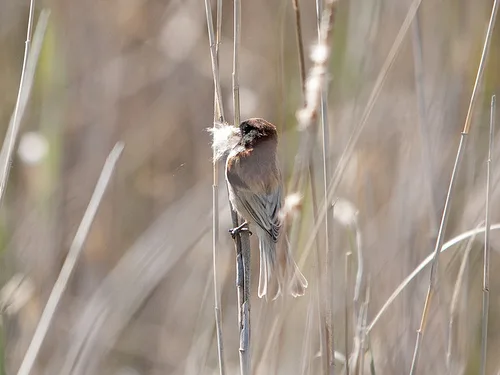
Black-headed Penduline Tit
[order] PASSERIFORMES | [family] Remizidae | [latin] Remiz macronyx | [UK] Black-headed Penduline Tit | [FR] Remiz a tete noire | [DE] Beutelmeise | [ES] Pajaro-moscon Cabecinegro | [NL]
Subspecies
| Genus | Species | subspecies | Breeding Range | Breeding Range 2 | Non Breeding Range |
| Remiz | macronyx | EU | c Asia | ||
| Remiz | macronyx | altaicus | |||
| Remiz | macronyx | macronyx | |||
| Remiz | macronyx | neglectus | |||
| Remiz | macronyx | nigricans | |||
| Remiz | macronyx | ssaposhnikowi |
Physical charateristics
Adult male of Black-headed Penduline Tit in spring has black head and neck. Chestnut-brown color of mantle is fluently paled in uppertail which is sandy; throat and craw are black; other underparts are buff-sandy with paler undertail. Shoulders, lesser and median upperwing coverts are chestnut; greater coverts are dark-brown with buffy edges. Flight and tail feathers are brown with pale-buff edges. Bill, tarsus and claws are black-brown. Adult female is similar on male but is distinguished by dim tones. In fresh autumn plumage pale-buff and white edges of feathers are heavy developed. Lore and ear coverts are black, fore-head is brown, mantle is dark-sandy, underparts are buff-white with some number of brownish feathers on breast. Juveniles in first plumage is similar on juveniles of Eurasian Penduline Tit but is distinguished by dark grayish crown and by dark strip on forehead and head-flanks.
| wingspan min.: | 16 | cm | wingspan max.: | 18 | cm |
| size min.: | 10 | cm | size max.: | 12 | cm |
| incubation min.: | 13 | days | incubation max.: | 14 | days |
| fledging min.: | 18 | days | fledging max.: | 14 | days |
| broods: | 2 | eggs min.: | 5 | ||
| eggs max.: | 9 |
Range
Eurasia : Central Asia
Habitat
It inhabits reed, mace and cane thickets on shallow water. On dispersal it visits thickets of some shrubs; and small reed-thickets with singly willows far from water.
Reproduction
It breeds in separate pairs. Nest is built between several reed stems at 0.4-1.6 m above water. Nest is from long reed stripes and vegetation fluff (willow, reed and rush), which is used not only to inside lining, but in construction of nest walls too. Breeding on bushes and trees is unknown. During two weeks or more nest is constructed mainly by male with some help of female which brings fluff. Clutches of 5-7 eggs founded from early May to early July. Both parents feed juveniles. Fledged young birds are observed from July to August. Probably two broods per season.
Feeding habits
Mainly larval insects, with spiders of considerable importance near beds of reed. Feeds mainly in trees, bushes, and reedbeds, sometimes in herb layer. Searches for food in outermost twigs and branches of trees, but also sometimes in bark crevices on trunk and bigger branches.
In spring, birds regularly visit flowers of willow to feed on insects.
In spring, birds regularly visit flowers of willow to feed on insects.
Conservation
This species has a large range, and hence does not approach the thresholds for Vulnerable under the range size criterion (Extent of Occurrence <20,000 km2 combined with a declining or fluctuating range size, habitat extent/quality, or population size and a small number of locations or severe fragmentation). The population trend appears to be stable, and hence the species does not approach the thresholds for Vulnerable under the population trend criterion (>30% decline over ten years or three generations). The population size has not been quantified, but it is not believed to approach the thresholds for Vulnerable under the population size criterion (<10,000 mature individuals with a continuing decline estimated to be >10% in ten years or three generations, or with a specified population structure). For these reasons the species is evaluated as Least Concern.

Migration
Resident, but northern populations move south after breeding.
Distribution map

